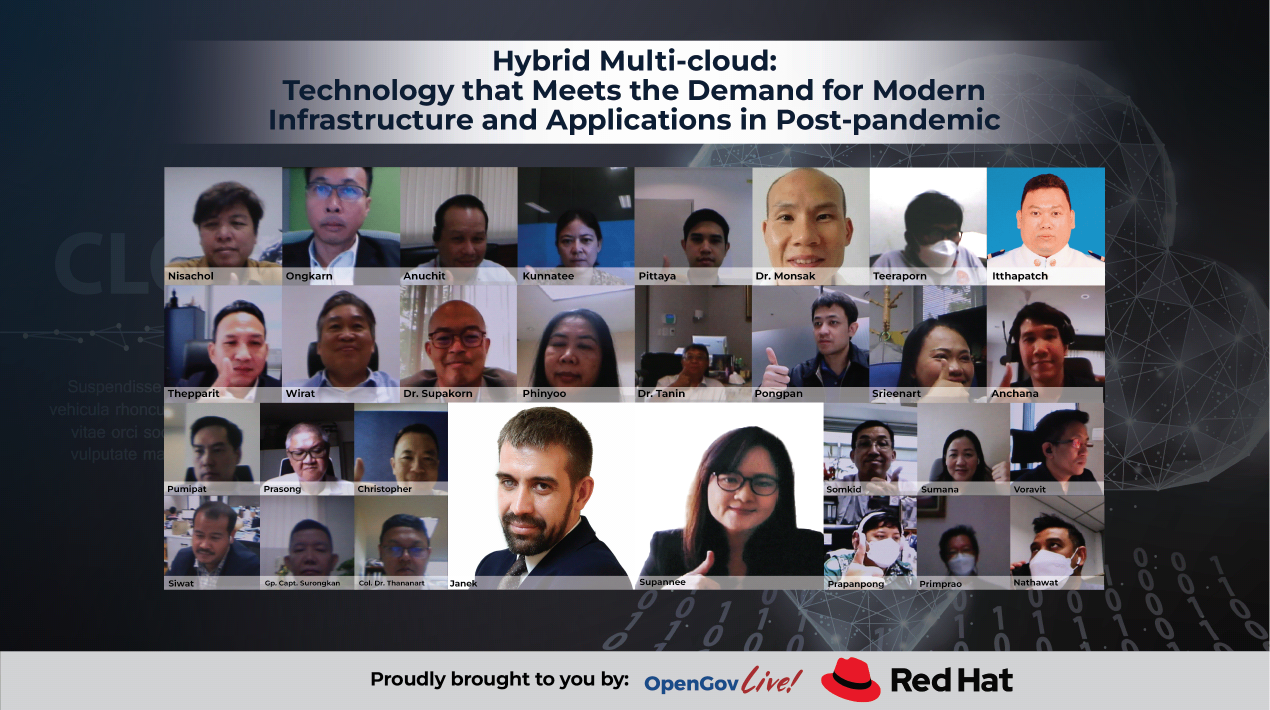
The rate of cloud adoption has accelerated because of the pandemic with various industries throughout the world transitioning to remote working and practically everything going digital. In this environment, the hybrid cloud, which offers enterprises the best of both worlds because of its inherent flexibility, agility and efficiencies, is foundational to success in the new normal.
Demand for infrastructure has impacted cloud services and hybrid cloud use is amping up significantly. A hybrid is a blend of public and private cloud platforms, delivering the best of both. Without a doubt, as technological barriers between the platforms decrease, hybrid cloud adoption will expand.
The OpenGovLive! Virtual Breakfast Insight held on 08 June 2022 focused on adopting a secure government-commercial cloud policy to hyper-scale digitalisation that results in greater levels of efficiency in public service.
The New Normal of Hybrid Work

Starting off the discussion, Mohit Sagar, Group Managing Director and Editor-in-Chief, OpenGov Asia, is convinced that hybrid work will be the new normal for most industries. This will allow employees to split their time between working in the office and working from home.
All technologies should be cloud-native, according to him, allowing businesses to design and deploy scalable applications in current, dynamic settings including public, private and hybrid clouds. It’s designed and engineered to take advantage of the cloud’s size, elasticity, robustness and adaptability.
“The pandemic impacted office culture quickly. Global lockdown and travel bans have changed work and corporate-government interactions. People have learned they can perform most things remotely,” observes Mohit.
Cloud-native solutions let enterprises design and run scalable applications in public, private and hybrid clouds – a huge advantage as both the private and public sectors attempt to save money by embracing technology.
To maintain public services, government organisations must keep expenses low while collecting, storing, updating and protecting data. Organisational leaders, especially in the government, must decide which culture changes to keep and which to combat as they adjust to the new normal and prepare for recovery.
Setting an example for the nation, the Government of Thailand recently looked at bolstering its tourist industry and enacted policies to encourage international travellers. The measures are promising and the World Bank predicts that the Thai economy will come back to pre-pandemic levels by the end of 2022.
Towards an Open Hybrid Cloud Future

Supannee Amnajmongkol, Country Manager, Red Hat Thailand spoke next on the future of an open hybrid cloud.
As society works to cope with the impact of COVID-19, whether in the public or private sectors, the need to adapt is growing, and innovation in the new normal has never been more important than today.
“Innovation remains the number one priority in the new normal,” according to Supannee. “Open-source communities are the innovation engine as the private sectors and even the government can use open-source viewpoints and collaboration to accelerate cloud innovation and deliver better products and services faster.”
Supannee added that the developers have designed a streamlined process to offer any software, anyplace, utilising best-of-breed services regardless of location.
The primary distinction between cloud and on-premises software, she believes, is where it is physically located. On-premises software is installed on the organisation’s computers and servers, whereas cloud software is hosted on the vendor’s server and accessed via a web browser.
Supannee acknowledges that hybrid is the reality for teams and IT environments, whereas the uniformity of environments is desired by operators to reduce operational complexity, lower costs and facilitate cross-environment interoperability. They require visibility throughout the full IT footprint of the organisation.
She also discussed the difference between the private and local clouds. Private clouds, often known as data centres, are hosted on a company’s infrastructure and are typically firewalled and physically secured. A local cloud is a dedicated cloud service that runs on-premises and is managed by a third party.
Most companies use more than one cloud because each cloud has its own features and benefits to offer. Cyber-security, however, is a must whichever cloud service provider is chosen and used. She added that a cloud service partner with a proven track record of successful cloud migrations guarantees success. Red Hat, the leading provider of enterprise open-source software solutions, makes an ideal partner.
Using ICT Capabilities to Transform the Public Sector

Janek Rozov, Head of Strategy at Information Technology and Development Centre, Ministry of Interior, Estonia elaborated on the uncontrolled and controlled cloud in the government sector.
Both individual services and public sector organisations have been designed and have moulded the country’s innovation and digitalisation policies. As digital technology becomes more extensively adopted, public service providers face increasing demands and expectations.
Firms should not entrust their access management and encryption to cloud service providers. This limits cloud service provider lock-in and preserves more confidence or control over who has access to which data.
On the other hand, unauthorised individuals can only access encrypted data. Not all data is sensitive, and risk-based data encryption requires data classification. Therefore, visibility of unauthorised cloud usages such as shadow IT, and unsanctioned IT is essential for establishing security controls or offering end-users and business units secure alternatives.
Governments have been compelled to maximise the value of becoming digital, with benefits ranging from increased efficiency to transparency. Janek feels it is essential for governments to keep in mind that they cannot replicate digital processes, but they can replicate the principles of how they might improve public procedures and lives in the face of the rapid digital shift.
Governments and agencies must determine how diverse social processes occur and how they are interconnected. After mapping the current level of public service supply, the institutional framework, and the cultural context, digitisation could create further benefits.
It is anticipated that citizens will demand and expect more from the public sector as services continue to shift to the digital platform. It may seem that governments are forced to play a never-ending game of catch-up, but efficiencies and transparency are improved over time.
As with most problem-solving, the first step is to separate the means from the goals. Before digitalisation moves forward, the government needs to figure out what people need. To get more people to use digital services, governments should avoid repeating complicated steps that slow down adoption.
Interactive Discussion
Following the informative presentations, delegates engaged in participatory dialogues aided by polling questions. This is intended to provide participants with professional learning and growth through live audience interaction, participation, and sharing of real-life experiences.
Delegates had the opportunity to learn from subject matter experts, share their experiences, and take methods back to their organisations.
The first poll asked the delegates what their organisation’s biggest challenge in digital transformation was. The majority (72%) went with people and skillsets while opted for scalability (21%) or common framework and platform (7%).
On being asked what cloud strategy delegates are interested in implementing, an overwhelming majority indicated hybrid cloud (72%). The remaining were evenly split between private cloud (14%) and multi-cloud (14%).
Inquiring about delegates’ top consideration in adopting multi-cloud, just under a third (30%) agreed that it was data sovereignty and residency (30%). The remainder were equally divided across cost optimisation (20%), tools and services available on the new cloud (20%) and inter-communication and workload portability among the clouds (20%).
Looking to see how delegates characterise their current stage of digital transformation in their respective organisations, well over half (57%) said that planning was conducted but there were delays in implementation and execution. About a quarter (23%) opted for pilot projects rolled out successfully and just under a fifth (19%) chose full-scale implementation of more than one program or project.
Asked how the delegates leverage data between other public sector agencies, about half (52%) said they used API Management, while the rest were equally split between inability due to security constraints (21%) and data integration (21%).
Janek shared that Point to Point is still an option but not as characterised by the API Management. He added that it is advisable to use third party infrastructure to secure the data.
Queried on the key value and driver of a public sector cloud offering, about 40% went with standardisation and governance (40%), followed by the total cost of ownership and price for investment (36%) and security (22%).
Ongkarn Nakprada, Head of Research and Development, National Intelligence Agency said that they are using the public cloud because the government allowed it for free and very efficient for the personnel as well. Pongpan Itsuwan, Chief of Computer Operation Section, Expressway Authority of Thailand shared that they prioritise privacy and personal information security.
On their plan to develop new applications and modernise their legacy applications, just under half (47%) opted to outsource (47%), while others went to re-write (26%) or SaaS (17%).
Siwat Panyachaiwatthanakool, Chief of Transport System Research and Development Section, Expressway Authority of Thailand felt that a starting company or organisation should outsource their platforms to ensure its security protocols.

inquiring as to what external assistance delegates think is needed most to accelerate their Digital Transformation journey, most (54%) felt having a mindset change and new ways of working were important. Others opted for building the framework and a standard platform (31%) or agile integration (9%).
Conclusion
The Breakfast Insight concluded with remarks from Christopher Tan, Global Partner Revenue Acceleration Director, APJ, Intel, who believes that digital ecosystems are frequently created and rapidly influencing change in a variety of sectors, including government.
Christopher urged the delegates to invest in their technology, as that is one of the most crucial elements to the ecosystem’s success. He was confident that Intel had innovative solutions for all their digital concerns.
Whether a company wants to safeguard a brand, intellectual capital and customer information, or offer controls for vital infrastructure, the tools for incident detection and response to defending organisational interests consist of people, procedures and technology.
Data security refers to the process of securing data throughout its lifecycle from illegal access and corruption. Globally, businesses even the government sector are investing extensively in information technology (IT) cyber security skills to safeguard their most valuable assets.
He encouraged the delegates to make sure that their cloud is fully set up by working with trusted partnerships. Cloud and cloud service providers like Red Hat allow adding and changing services straightforward without increasing or deleting digital space. Thus, there is no worry about restricted resources, buying and housing servers and hardware, updating software or data protection.
“Thailand has incredible tourist destinations and production will go up in the manufacturing industry; so every aspect of government service must be fully functional,” Mohit concludes.
Thailand is on a massive digital transformation journey, Mohit acknowledges and reminds delegates that there are people who are willing to help them. He invited them to reach out to the sessions resource persons and experts to explore how to best progress on their transformation journeys.
















